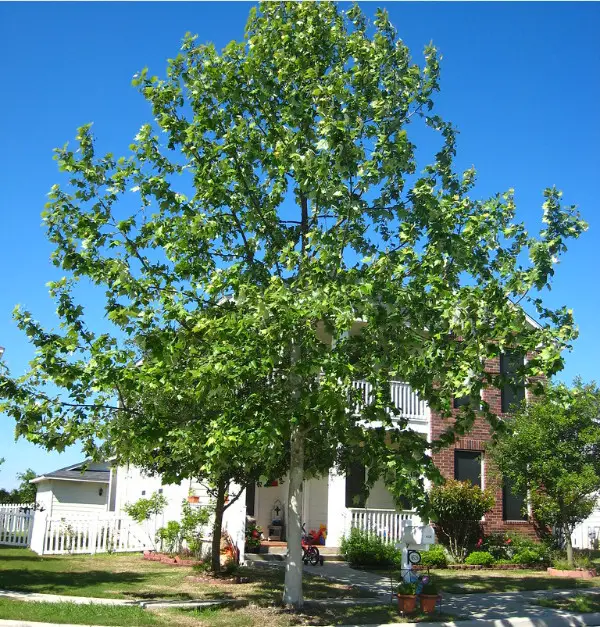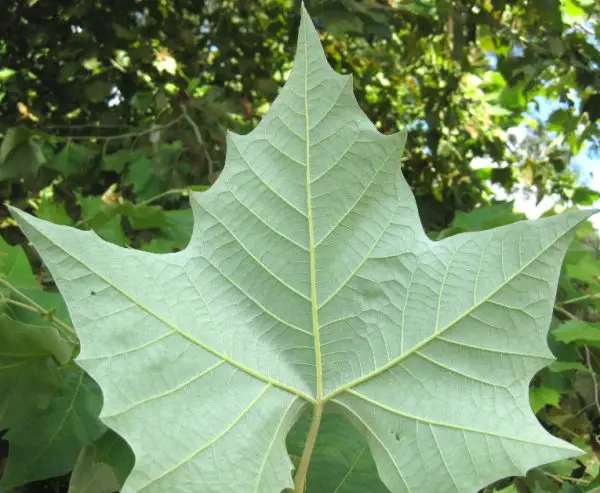The Mexican sycamore tree is a majestic species renowned for its vibrant beauty and resilience. Whether you’re a seasoned gardener or a novice enthusiast, this detailed guide aims to provide you with all the essential information you need to cultivate and care for Mexican sycamores with confidence.
About the Mexican Sycamore Tree

The Mexican sycamore (Platanus mexicana) is a drought-tolerant, quickly-growing tree with enormous, maple-like leaves that have a velvety, silver underside. It also has smooth, white-and-tan bark. This tree is native to northern and central Mexico; its tolerance to cold is unclear. Nonetheless, Mexican sycamore thrives in USDA Cold Hardiness Zone 8b in Texas and Florida, which is quite far north.
The Mexican sycamore, is marginally smaller than the native American sycamore. Mexican sycamore normally reaches a mature height of 50 feet in the landscape with a width of around 30 feet, while it is known to grow up to 80 feet or more in the wild. The tree is deciduous and has a circular crown that is erect. Mexican sycamore grows best in full sun and can tolerate most types of soil, even alkaline soils. Even though they are thought to be drought-hardy, plants do best when they are watered until they become established.
The olive-green, lobed leaves resemble maples and can grow up to 8 inches broad. They can occasionally turn yellow before dropping in December. Mature trees (at least 4 to 6 years old) have leaf undersides that are attractively silvery due to the development of short, thick, whitish hairs. In areas where leaves need to be raked, the big leaves may become an annoyance. Similar to the American sycamore, this tree should not be planted close to buildings, pavement, or power lines due to its invasive roots and very large mature size.

From December through February, the male and female blooms on the same plant are borne independently and resemble greenish balls hanging from the branches. April through August bring about aggregate-like fruit with a diameter of around 1 1/2 inches.
Mexican Sycamore Tree Care and Growing Guide
The Mexican sycamore (Platanus mexicana) is a beautiful tree known for its striking bark, large leaves, and tolerance to heat and drought once established. Here’s a care and growing guide to help you cultivate and maintain a healthy Mexican sycamore tree:
Location
When selecting the perfect spot to plant Mexican sycamores, it’s essential to opt for a location basking in sunlight with soil that drains well. These resilient trees thrive under the warmth of the full sun but can also adapt to a bit of shade if necessary. So, whether it’s a sun-drenched corner of your garden or a partially shaded area, Mexican sycamores will find a way to flourish and bring their majestic presence to your landscape.
Soil
Mexican sycamores are incredibly versatile when it comes to soil preferences, thriving in various soil types, be it sandy, loamy, or clay, as long as the soil is well-draining. To guarantee optimal growth, it’s essential to maintain a soil pH that ranges from neutral to slightly acidic. With these soil conditions met, Mexican sycamores will eagerly establish themselves and grace your landscape with their stunning presence.
Watering
Mexican sycamores exhibit remarkable resilience to drought once they’ve settled into their surroundings. However, during their initial years, they greatly appreciated consistent watering to aid in their establishment. It’s advisable to provide regular watering sessions, particularly during dry spells, to ensure their vitality and growth.
When watering, the key is to allow the water to penetrate deeply into the soil rather than frequent shallow watering, as this encourages the development of a robust root system that can better withstand periods of drought.
Mulching
To ensure the optimal health and vigor of Mexican sycamores, mulching is a highly beneficial practice to incorporate into your gardening routine. By applying a generous layer of organic mulch, such as wood chips or bark, around the base of the tree, you create a protective barrier that helps retain soil moisture and suppress the growth of weeds.
However, it’s crucial to leave a small gap between the mulch and the trunk to prevent moisture-related diseases from affecting the tree. This simple yet effective mulching technique not only conserves moisture in the soil but also contributes to the overall health and vitality of Mexican sycamores, enhancing their beauty and longevity in your landscape.
Fertilization
Mexican sycamores typically thrive without the need for frequent fertilization, especially when planted in soil that is naturally nutrient-rich. However, in cases where the soil quality is poor or if the tree exhibits signs of nutrient deficiency, supplemental fertilization can be beneficial.
Applying a balanced fertilizer in the early spring provides the tree with essential nutrients to support healthy growth and development. It’s important to assess the condition of the soil and the tree’s overall health before deciding to fertilize, as excessive fertilization can lead to nutrient imbalances or other issues.
Pruning
Pruning is a crucial aspect of Mexican sycamore tree care, best performed during the dormant season, which spans from late fall to early spring. This strategic timing allows for the removal of dead, damaged, or crossing branches without interfering with the tree’s active growth periods. By carefully pruning during this time, you not only enhance the tree’s aesthetic appeal but also encourage healthy growth and development.
Removing these problematic branches improves the overall structure of the tree, allowing for better airflow and sunlight penetration throughout its canopy. With proper pruning practices in place, Mexican sycamores can thrive and flourish, adding beauty and vitality to your landscape year after year.
Pest and Disease Management
Mexican sycamores stand out for their robust resilience against pests and diseases, yet, like any living organism, they aren’t entirely immune. Despite their overall hardiness, occasional encounters with powdery mildew, anthracnose, or sycamore lace bugs may arise. It’s prudent to keep a vigilant eye on your tree, conducting regular inspections for any telltale signs of these pests or diseases. Should you detect any symptoms, swift action is paramount.
Anthracnose manifests as light brown lesions along leaf veins, often escalating to severe leaf drop and canker formation if left unchecked. Conversely, powdery mildew manifests as a powdery white residue coating the leaves.
Implementing appropriate measures promptly can help thwart the progression of these issues. Whether it’s targeted pesticide applications, cultural practices, or natural remedies, addressing pest and disease concerns in a timely manner is key to preserving the health and vitality of your Mexican sycamore.
Winter Protection (in colder climates)
In regions where winters bring harsher conditions than Mexican sycamores typically encounter, some extra care may be necessary to safeguard these resilient trees. While they boast hardiness suited for USDA zones 7–10, colder climates may warrant additional winter protection measures. Wrapping the trunk with burlap or employing tree wraps serves as a shield against potential threats like sunscald or frost damage during the colder months.
This simple yet effective practice helps insulate the tree’s delicate bark from extreme temperature fluctuations and harsh winter elements, ensuring its continued health and vigor.
Spacing
When it comes to planting Mexican sycamores, adequate spacing is key to accommodating their grandeur and allowing them to flourish to their full potential. To ensure ample room for their expansive canopy to spread and thrive, it’s recommended to plant these majestic trees at least 20–30 feet apart. This generous spacing not only provides each tree with the necessary breathing space but also prevents overcrowding, which can inhibit their growth and development.
Support
Supporting young Mexican sycamore trees during their early stages of growth can significantly contribute to the development of a sturdy and upright structure. Staking or bracing these saplings provides crucial support, particularly in windy conditions or when the soil is loose and unstable. By anchoring them securely, you not only protect them from potential damage but also encourage proper root establishment and upward growth.
Monitor Growth
Keeping a close eye on the growth and well-being of your Mexican sycamore tree is essential for maintaining its health and vitality over time. Regular monitoring allows you to observe how the tree is responding to its environment and any care practices you’ve implemented. By paying attention to factors such as leaf color, foliage density, and overall growth rate, you can identify any potential issues early on and adjust your care regimen accordingly.
Be proactive in responding to changes in environmental conditions, such as fluctuations in temperature or moisture levels, as these can impact the tree’s health. Additionally, be mindful of any signs of pest infestation or disease symptoms and address them promptly to prevent further damage.
Mexican sycamore tree vs American sycamore tree
When comparing the Mexican sycamore tree to its American counterpart, one notable distinction is its size and availability. While both species offer striking beauty, the Mexican sycamore presents an attractive, smaller statured alternative to the American sycamore. However, the Mexican variety is not as commonly grown by Florida nurseries, making it a somewhat elusive find for enthusiasts in the region.






